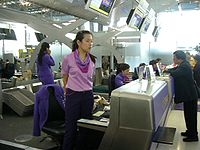
Photo from wikipedia
According to Airport Council International, Juanda International Airport (JIA) is the second busiest airport in Indonesia. JIA has two terminals: The domestic terminal (T1) has an area of 62,700 m2,… Click to show full abstract
According to Airport Council International, Juanda International Airport (JIA) is the second busiest airport in Indonesia. JIA has two terminals: The domestic terminal (T1) has an area of 62,700 m2, while the international terminal (T1) covers an area of 49,000 m2. Both T1 and T2 were designed to accommodate 12.5 million passengers per year; in 2015, the actual number of passengers passing through the terminals reached 17 million. Therefore, the purpose of this research was to find a solution to the terminals’ overcapacity (or congestion) problem by analyzing the factors affecting the efficiency of the existing terminals. This research uses analytic hierarchy process (AHP), a three-level process consisting of goals, criteria, and sub criteria. The main objective of this research is determining the factor that most affects the efficiency levels of T1 and T2. Three priority variables were identified - convenience, punctuality, and accessibility. The sub criteria include the processes that a passenger must go through when using the passenger terminal, including the security check point 1 (SCP I) and the security check point 2 (SCP II), check-in, walking time, and boarding lounge. The analysis results show that the factors that influence the efficiency of T1 were check-in process (32.7%), SCP I (32.4%), walking time and SCP II (13.2%), and boarding lounge (8.5%). The factors which influence the effectiveness of T2 were 28.1% for SCP I, 26.9% for check-in process, 17.9% for walking time I, 10.6% for SCP II, 9.9% for walking time II and 6.6% for boarding lounge. Thus, the factors affecting both terminals’ efficiency are the processes of SCP I and check-in process when passengers first access the terminal.
Journal Title: Ksce Journal of Civil Engineering
Year Published: 2020
Link to full text (if available)
Share on Social Media: Sign Up to like & get
recommendations!